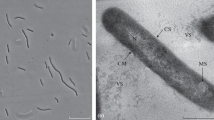Abstract
The isolation and characterization of a new methanogenic bacterium,Methanobacterium arbophilicum, is described. Isolation from wetwood enrichment cultures, that were obtained from methane-positive trees, required a medium containing inorganic salts, vitamins, and an atmosphere consisting of an 80∶20 mixture of hydrogen-carbon dioxide. Isolates ofM. arbophilicum were gram-positive, non-motile short rods that occurred singly, in pairs, or chains. The organism was found to be an autotroph and a strict anaerobe, and to have a pH optimum of 7.5–8.0. The optimal temperature for growth was 30 to 37C, the maximum being 45C and the minimum about 10C. The organism had obligate growth requirements for H2 and CO2, and organic compounds greatly stimulated growth. The generation time in shake flask culture was about 17 hr in mineral salts medium and about 13 hr in complex medium. The DNA base composition was 27.5 mol % GC.
Similar content being viewed by others
References
Aho, P. E., Seidler, R. J., Evans, H. T. andRaju, P. N. 1974. Distribution, enumeration and identification of nitrogen-fixing bacteria associated with decay in living white fir trees. —Phytopathology64: 1413–1420.
Bryant, M. P. 1972. Commentary on the Hungate technique for culture of anaerobic bacteria. —Am. J. Clin. Nutr.25: 1324–1328.
Bryant, M. P. 1974. Methane-producing bacteria. Part B. 472–477.In R. E. Buchanan and N. E. Gibbons, (eds.), Bergey's Manual of Determinative Bacteriology, 8th Ed.—Williams and Wilkins Co., Baltimore.
Bryant, M. P., Tzeng, S. F., Robinson, I. M. andJoyner, A. E., Jr. 1971. Nutrient requirements of methanogenic bacteria, p. 23–40.In F. G. Pohland, Anaerobic biological treatment processes.—Advances in Chemistry, Series, 105, American Chem. Soc., Washington, D.C.
Carter, J. C. 1945. Wetwood of elms. Ill. Dat. Hist. Surv. Bull.23: 407–448.
Daniels, L. andZeikus, J. G. 1975. Improved culture flask for obligate anaerobes.—Appl. Microbiol.29: 710–711.
De Ley, J. 1970. Reexamination of the association between melting point, buoyant density, and chemical base composition of deoxyribonucleic acid.—J. Bacteriol.101: 738–754.
Hartley, C. R., Davidson, W. andCrandall, B. S. 1961. Wetwood, bacteria and increased pH in trees.—U.S. Dept. Agric. For. Service, For. Prod. Lab., Rep. 2215.
Hungate, R. E. 1969. A roll tube method for cultivation of strict anaerobes, p. 117.In J. R. Norris and D. W. Ribbons, (eds.), Methods in Microbiology, Vol. 3B.—Academic Press, New York.
Knutson, P. M. 1973. The bacteria in sapwood, wetwood and heartwood of trembling aspen (Populus tremuloides).—Can. J. Bot.51: 498–500.
Marmur, J. 1961. A procedure for the isolation of deoxyribonucleic acid from micro-organisms. —J. Mol. Biol.3: 208–218.
Nelson, D. R. andZeikus, J. G. 1974. Rapid method for the radioisotopic analysis of gaseous end products of anaerobic metabolism.—Appl. Microbiol.28: 258–261.
Schildkraut, C. L., Marmur, J. andDoty, P. 1962. Determination of the base composition of deoxyribonucleic acid from its buoyant density in CsCl.—J. Mol. Biol.4 430–443.
Stankewich, J. P., Cosenza, B. J. andShigo, A. L. 1971.Clostridium quercicolum sp. n., isolated from discolored tissues in living oak trees.—Antonie van Leeuwenhoek37: 299–302.
Ward, J. C., Kuntz, J. E. andMcCoy, E. M. 1969. Bacteria associated with shake in broadleaf trees.—Phytopathology59: 1056.
Wolin, E. A., Wolin, M. J. andWolfe, R. S. 1963. Formation of methane by bacterial extracts.—J. Biol. Chem.238: 2882–2886.
Zeikus, J. G. andBowen, V. G. 1975. Comparative ultrastructure of methanogenic bacteria. —Can. J. Microbiol21: 121–129.
Zeikus, J. G. andWard, J. C. 1974. Methane formation in living trees: a microbial origin.— Science184: 1181–1183.
Zeikus, J. G., Weimer, P. J., Nelson, D. R. andDaniels, L. 1975. Bacterial methanogenesis: acetate as a methane precursor in pure culture.—Arch. Microbiol.104: 129–134.
Zeikus, J. G. andWolfe, R. S. 1972.Methanobacterium thermoautotrophicum sp. n., an anaerobic autotrophic, extreme thermophile.—J. Bacteriol.109: 707–713.
Author information
Authors and Affiliations
Rights and permissions
About this article
Cite this article
Zeikus, J.G., Henning, D.L. Methanobacterium arbophilicum sp. nov. An obligate anaerobe isolated from wetwood of living trees. Antonie van Leeuwenhoek 41, 543–552 (1975). https://doi.org/10.1007/BF02565096
Received:
Issue Date:
DOI: https://doi.org/10.1007/BF02565096



